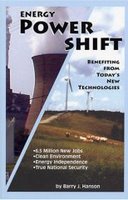Decentralized Renewable Energy Builds Communities
 As a wide variety of bioenergy systems are being planned to supplement and/or eventually replace the existing fossil fuel infrastructure, the added benefits of decentralization are being anticipated. Imagine - customizable solutions based on the local ecology of the host community. Biofuels fermented from local crops or waste. Electricity harvested from installed solar panels and windmills. Smaller-scale commercial generators and fuel cells strategically located near industrial parks. Many of the components of community based systems are described in Barry Hanson's excellent book Energy Power Shift.
As a wide variety of bioenergy systems are being planned to supplement and/or eventually replace the existing fossil fuel infrastructure, the added benefits of decentralization are being anticipated. Imagine - customizable solutions based on the local ecology of the host community. Biofuels fermented from local crops or waste. Electricity harvested from installed solar panels and windmills. Smaller-scale commercial generators and fuel cells strategically located near industrial parks. Many of the components of community based systems are described in Barry Hanson's excellent book Energy Power Shift.
In an article written by Cindy Zimmerman of Domestic Fuel titled Locally-Owned Plants Better For Local Economies she reports on a study released by the National Corn Growers Association that contends that "ethanol plants owned by local farmers provide more economic benefits for communities than those owned by absentee investors."
“Since a farmer-owned cooperative ethanol plant is literally a member of the community, the full contribution to the local economy is likely to be as much as 56 percent larger than the impact of an absentee-owned corporate plant.”
Two main reasons are given for that conclusion:
1. The share of expenditures for operations of a farmer-owned plant derived in the local community is likely to be larger than that of an absentee-owned plant.
2. Farmer-owners of a cooperative or limited liability corporation (LLC) ethanol plant will participate in the profits through dividends.
On September 11th, Renewable Energy Access carried a similar story that focused on other benefits for investors, the workforce, and building more community cohesion - "a healthier society." Here are mere excerpts - the article is so good I recommend going to the source.
--------------
Community Renewable Energy Is Just Around the Corner
by Ted Bernhard
Although the shift toward large-scale renewable energy has already begun to make a positive difference, today the U.S. finds itself on the verge of another new wave of thinking that incorporates the lessons of the past, but goes beyond merely addressing cost and environmental concerns and seeking maximum output. This new model, which is gradually and quietly rolling into communities across the country, is the distributed "community renewables" model, in which new power projects are smaller and tightly integrated with local communities and local resources in a way that the economics become more favorable and communities are able to participate directly in some of the benefits.
There are three characteristics that distinguish distributed community renewables from the "cheaper at any cost" and the "mega-renewable deployment" mindsets.
1. Increased Community Participation. Unlike a project developed, financed and controlled exclusively by an external developer, community energy projects actively seek to involve local communities as much as realistically possible. This can be done by using fuel from local feedstocks or natural resources; hiring local contractors for construction, administration, management and maintenance roles; giving the local community members an opportunity to invest and share directly in the project's financial benefits (particularly on the back end); creating additional tax revenue for the local governments, and even, in some cases, selling the power produced to local individuals and businesses.
2. Smaller-Scale Projects. Project size is driven primarily by federal, state, and local tax incentives; the proximity and availability of natural resources; and the ability to transmit power to customers... Some developers are also beginning to explore innovative ways to sell their projects' power to the local communities themselves or on the open market.
3. Additional Societal Benefits. Finally, community renewables projects create a wide range of social benefits that transcend the economics of a particular project. These include decreased dependence on foreign natural gas and oil, a power infrastructure that is far less subject to large-scale disruption or terrorism because of its distributed and diverse nature, local control of generation facilities, creation of much needed high-quality jobs in rural areas, and a supplemental revenue stream for agricultural community members that allows them to maintain their rural lifestyle. Additionally, this approach has demonstrated an uncanny ability to bring together people from very different backgrounds -- Republicans and Democrats, urban and rural residents, businesses and environmentalists -- for a common cause.
Utilities and large-scale commercial developers also are beginning to recognize the wisdom of this approach as complementary to their own efforts, because it often helps familiarize local communities with the benefits of renewable projects and ends up making it easier to get their larger projects sited in the future. Some even like the model so much that they are considering building some of these types of projects themselves as a way to replace aging facilities in difficult-to-reach rural areas.
One thing is for sure: when done right, investment in community renewables can be highly profitable for investors. This is because they offer:
-- Higher risk-adjusted return than virtually any other investment...
-- Sustainable long-term business models..
-- Increased operational efficiencies..
The community renewables projects breaking ground today are just the beginning. As the full value of carbon emissions savings become a tradable commodity, and as new storage and interconnection technologies become available, the distributed community renewables energy model has the opportunity to become an increasingly significant piece of broader efforts moving us toward clean energy and a healthier society.
Ted Bernhard's firm is sponsoring a conference called Investing for Clean Energy in the Pacific Northwest on October 4, 2006 in Seattle, which is designed to explore investor-related renewable energy issues with some of the nation's most active and successful clean energy investors.
technorati bioenergy, conversion, biofuels, decentralization, renewable, investment



No comments:
Post a Comment